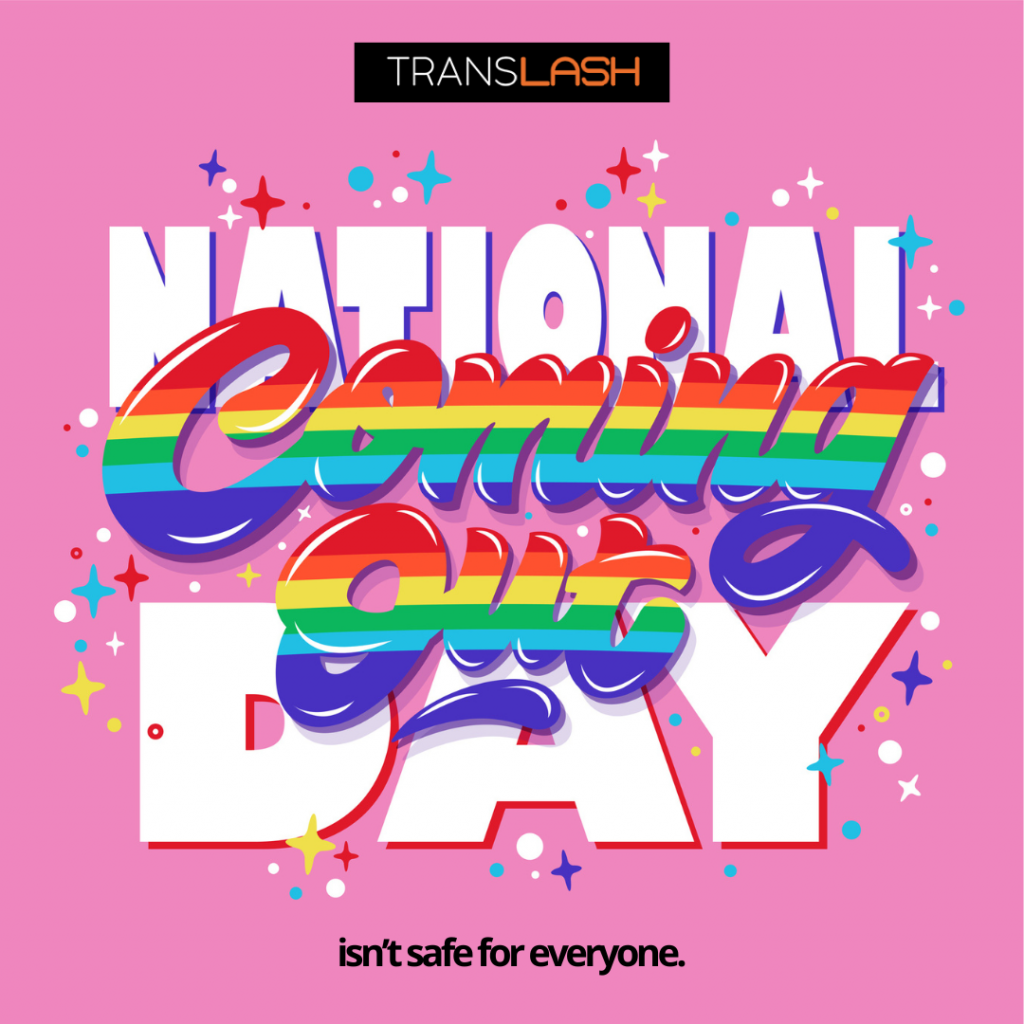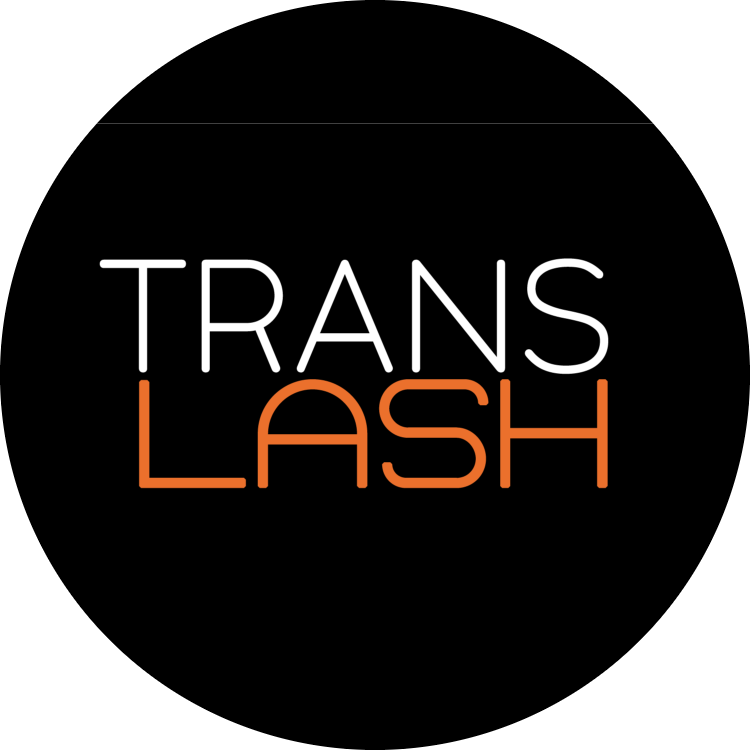By Daniela “Dani” Capistrano for TransLash Media
National Coming Out Day is a complicated holiday for many queer, trans, two-spirit, intersex, and gender nonconforming people. Sound familiar? Then you’re in the right place! Explore our trans-affirming guide:

Much like an illustrator’s style, the optics of this holiday aren’t for everyone. A colorful, bold, and public LGBTQ+ life isn’t in the cards for everyone today and that reality is valid. We can celebrate folks who have come out of the closet while also honoring the decision to not be out.
WHAT IS NATIONAL COMING OUT DAY?
National Coming Out Day (NCOD) is observed on October 11 each year to support anyone “coming out of the closet.” Often shortened to coming out, this saying is a metaphor used to describe LGBTQ+ peoples’ self-disclosure of their sexual orientation, romantic orientation or gender identity. In 1990, NCOD merged its efforts with the Human Rights Campaign (HRC).
Today, the holiday is often seen as a mainstream, social media-focused event, but NCOD was first celebrated in the United States in 1988 as an intervention tied to addressing skyrocketing discrimination of people with AIDS/HIV who were often (but not always) LGBTQ+.
In October of that year, at the height of the AIDS crisis, people around the country received white envelopes in their mailboxes. Vibrant purple and magenta letters spelled out “National Coming Out Day,” with the tag line, “Take your next step.”
Inside were bumper stickers with the NCOD logo, a pamphlet of ideas about how and why to come out as gay or lesbian, and a little white card — the commitment card. The instructions were clear: On Oct. 11, sign your name on the carbon copy paper, proclaiming you were gay or lesbian. Then send one copy back to NCOD headquarters and give the other to a trusted friend. NCOD would compile a commemorative journal listing the names of all the respondents.
“No matter how far in the closet or out of the closet you are, you have a NEXT STEP,” proclaimed the mailing, an attempt to comfort a scared population.
NCOD was founded by LGBTQ+ activists Robert Eichberg and Jean O’Leary. They chose Oct. 11 for NCOD because it was the date, one year earlier, of the Second Gay and Lesbian March on Washington, when hundreds of thousands of queer people and allies marched on the Capitol in Washington to demand action on AIDS.
The initial idea for NCOD was grounded in the feminist and gay liberation spirit of the personal being political, with an emphasis on the most basic form of activism being coming out to family, friends, and colleagues, and living life as an openly lesbian or gay person. The founders believed that homophobia thrives in an atmosphere of silence and ignorance and that once people know that they have loved ones who are lesbian or gay, they are far less likely to maintain homophobic or oppressive views.
Establishing NCOD can now be viewed as an attempt at intersectionality before the concept was introduced by Kimberlé Crenshaw in 1989; NCOD served to connect LGBTQ+ people and allies with HIV/AIDS patients and allies, supporting coalition-building during a time of devastating misinformation being spread about LGBTQ+ people and people with HIV/AIDS.
Unfortunately, back in the 1980s, the premise of National Coming Out Day wasn’t inclusive of the diverse realities of trans, intersex, two-spirit, and gender nonconforming people. These categories weren’t even included in the initial mailer; the commitment card only listed gay or lesbian as a choice.
Today, while HRC and other specific communities and outlets do approach National Coming Out Day through an intersectional lens, mainstream media continues to encourage people to come out without addressing the risk of doing so.
In 2023, LGBTQ+ people who choose to remain in the closest (or to return to it) can sometimes feel alienated by the emphasis on “living your truth” while facing real-world dangers.
WHY DO SOME PEOPLE CHOOSE TO NOT COME OUT?
In the United States, HRC sponsors NCOD events through their National Coming Out Project, offering resources to LGBTQ+ people of all ages, including allies, to promote awareness of LGBTQ+ families living open lives.
While it is still necessary to cultivate safe spaces and resources for LGBTQ+ people to be affirmed and supported in living out loud, it’s equally important to continue to unpack the individual and systemic reasons for why LGBTQ+ people remain in the closet decades after NCOD was founded.
Preston Mitchum, a black queer writer, wrote in his 2013 article for The Atlantic “On National Coming Out Day, Don’t Disparage the Closet” that coming out may not always be safe for LGBTQ+ people in multiple marginalized communities.
Mitchum also suggests that coming out can lead to hypervisibility for those with intersecting identities, potentially leading to discrimination in the workplace, family exile, violence, and criminalization.
Coming out (or inviting in) isn’t a simple or safe process for many people. With over 500 anti-trans bills being pushed in 2023 alone, it can feel very scary to be a publicly visible trans person in America.
Additionally, coming out isn’t always linear; a person could be out as a cisgender queer person in one decade and then as a trans person in the next. Someone could be out as trans for years and then detransition for safety reasons.
Here are a few more reasons why some LGBTQ+ people don’t come out:
- Financial Abuse: an LGBTQ+ closeted person in an abusive relationship of any type is vulnerable, but especially when their primary abuser controls their access to money and how they can spend that money. A person of any age could remain in the closet for years while being controlled financially by their abuser, who may use threats and manipulation to control their victim. It can take a long time for a person navigating domestic violence to access the resources they need to leave, so staying in the closet is often a survival tactic for LGBTQ+ people.
- Legalized Transphobia: take your pick; everything from the Gay/Trans Panic Defense, to being denied access to affirming healthcare, to workplace discrimination—there is a real price that many trans people pay for living their truth in public.
- Family Abuse: you likely know at least one person who was kicked out & shunned by their family for being LGBTQ+. This form of abuse and neglect continues in 2023. Beyond housing insecurity, coming out to a largely homophobic and transphobic immediate or extended family can open the door to real dangers and years of emotional abuse and manipulation. Many LGBTQ+ folks don’t feel comfortable coming out to the world before they come out to their family, so they remain in the closet.
- Cultural Differences: for some Black and brown (and white!) folks, there is never a formal “coming out.” Everyone in the family may already know that an aunt, uncle, cousin, sister, brother, etc. is LGBTQ+, but not openly discuss it. These LGBTQ+ folks may even involve their partners/lovers in family traditions, but may still never “formally” come out to their families or the public. They simply want to be treated like everyone else and don’t relate to National Coming Out Day.
- White Privilege: Black trans people face the highest levels of interpersonal and systemic oppression. We don’t all share the same experiences as LGBTQ+ people, including within trans communities offline and online. White trans people don’t experience anti-Blackness or carry the weight of Black hypervisibility that often permeates workplace, academic, and many social settings. A white trans person with class privilege may “feel” safe to be out as trans today without realizing how their white privilege plays into that experience of safety.
It’s essential to approach National Coming Out Day with an intersectional lens, especially as a privileged LGBTQ+ person.
If you are fortunate enough to have stable housing and employment, a support network of blood and chosen family, few or no disabilities, and live in a city with many legal protections for LGBTQ+ people, then coming out may still be emotionally scary for you (and that’s valid!), while being emotionally and systemically scary for someone else who doesn’t hold all of your privileges.
A closeted LGBTQ+ person may not be ready to invite people in until things tangibly change around them; until it’s emotionally, materially, logistically, and legally safe to be out.
TRANS-AFFIRMING RESOURCES
Did you find this resource helpful? Consider supporting TransLash today with a tax-deductible donation.


